Vintage German Cameras
Vintage German Cameras
Vintage Domestic Cameras
Vintage Japanese Cameras
Vintage Former Soviet Union Cameras
Vintage Polaroid Cameras
Vintage Prime Lens Comparison
Vintage Photography Accessories
Gallery of Images from Vintage Cameras

1932 Kodak Vollenda 48
The Kodak Vollenda 48, made from 1929 to 1937, was originally built by Nagel Kamera-Werke, and then by Kodak AG in Stuttgart, Germany, after 1931. The Kodak Vollenda 48 was a very high quality, tiny half-frame folding camera producing 16 exposures on a roll of 127 film. It was available with a variety of lenses. This example has a Schneider-Kreuznach Radionar 50mm f/3.5 lens and Compur shutter with speeds from 1s to 1/300s, plus T and B. Apertures range from f/3.5 to f/16. The lens focusses from 3.5 feet to infinity. This is a very small camera, just 4-1/2" x 3-1/8" x 1-1/4"
I found this one on EBay, and with a little restoration work, it turned out to be a very nice example, except for a broken lens board latch. It appears to be in good mechanical condition otherwise. I cleaned all the bright work with alcohol and Q-tips, and gave the leather covering a fresh coat of black shoe dye and polish. Some of the black paint has worn off the metal trim and viewfinder, but I left that as found.
The Kodak Vollenda is very well made, solid, and the controls work smoothly and with precision. Its US price was $33.50, a real bargain compared to the Leica and Zeiss cameras of the same era that cost hundreds of dollars.
The Kodak Vollenda played a prominent role in the first season of the 2020 Perry Mason reboot starring Matthew Rhys. In the new show, the Perry Mason character is a private investigator before he becomes a lawyer. A Kodak Vollenda is featured as a prop camera Mason uses in his investigative work.
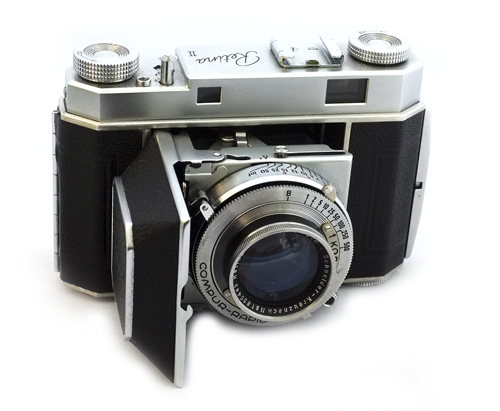
Kodak Retina II 35mm Camera (Type 011)
The Kodak Retina series of cameras were designed and manufactured at the Kodak AG works in Stuttgart, Germany from 1934 to 1969. The Retina cameras were exceptionally well designed and built to compete with the Leica and Contax cameras, and are considered by many to be worthy competitors.
When I decided to buy a working Retina to use for film shooting, I first considered the last model, the Retina IIIC (not the IIIc). The main feature I liked about the Retina IIIC is the extra large viewfinder, which is helpful for those who wear glasses. However, the built in light meters are long dead, and the bottom mounted rapid wind film advance lever is somewhat fragile. Also I didn't care for the shift from standard lens markings to EV values.
After careful research, I decided on the Retina II, a very well built, but old school mechanical, manual camera. It has a sturdy film advance knob, no light meter, and a manually set shutter. The lens settings are standard f/stops and fractions of seconds. On the downside, the combined viewfinder/rangefinder window is small, so composing an image is a challenge if you wear glasses. And it lacks strap lugs, so I keep the camera in its leather case without the top cover. The Retina II was produced from 1936 to 1950.
The camera lens, like most of the Kodak cameras produced in Stuttgart, is a very sharp Schneider-Kreuznach 50mm f/2 lens. The Compur Rapid shutter features speeds of B, 1s,2s,5s,1/10,1/25,1/50,1/100,1/250,and 1/500.
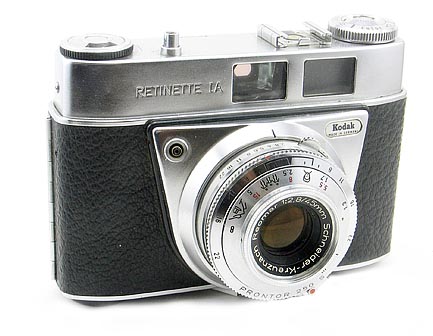
Kodak Retinette 1A 35mm Rangefinder Camera
Made by the German division of Kodak, the Retinette was produced from 1959 to 1966. It used a Compur shutter, similar to the one shown on the Retina above. This one belonged to my sister, who probably picked it up used in Germany in the 1970's.
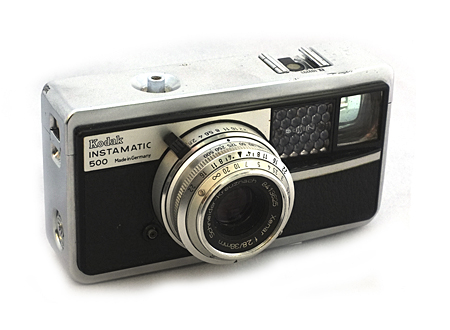
1964 Kodak Instamatic 500 Camera
The Kodak Instamatic cameras were very successful, and many models were produced over the years. One of the very best was produced by Kodak's German subsidiary in Stuttgart, Germany. The 500 features a built-in light meter, rapid film advance, tripod socket, cable release threads in the shutter release, and a fully adjustable Schneider-Kreuznach 38mm f/2.8 lens, with shutter speeds from B to 1/500s.
Like most Instamatics, the camera uses 126 cartridge film, which is no longer available. However, expired film can be found online, which can be used with compensation for the age, and it is even possible to load 35mm film into a 126 cartridge.
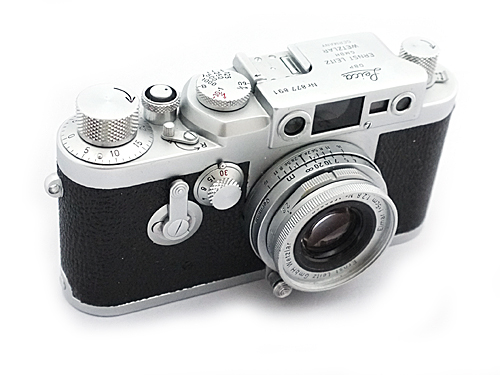
1957 Leica IIIg
The Leica IIIg is the last in the long line of screw mount Leica cameras. It was produced from 1956 to 1960. The Leica IIIg was introduced after the completely redesigned Leica M3. Although it still had separate rangefinder and viewfinder windows, they were larger and brighter than previous models. I purchased this body on EBay. I already had the Elmar f/2.8 50mm lens that Leica introduced in 1957. After shooting an entire roll of film without extending the Elmar lens, I opted to mount a LTM Canon f/1.8 50mm fixed lens for most photography. I also have the Elmar f/4 90mm telephoto lens. The IIIg has built-in frame lines for both the 50mm and 90mm lenses.
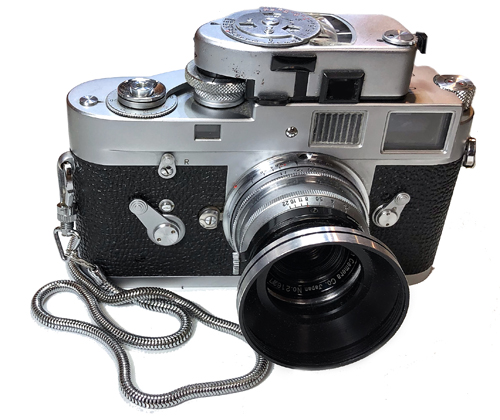
1959 Leica M2 with Self-Timer and Leicameter MR
The Leica M2, which followed the legendary Leica M3 of 1954, was introduced in 1957 and remained in production until 1968. The M3 was the first Leica camera to have an integrated rangefinder and viewfinder. It also abandoned the Leica threaded lens mount for a bayonet mount, although all the threaded Leica lenses may be used with a simple adapter.
The M3 was a slightly more expensive camera than the M2, as it had an automatic film frame counter and some fancier framing around the front viewfinder and rangefinder windows. It had framing lines in the viewfinder for 50mm, 90mm and 135mm lenses, all visible at the same time, which made for a somewhat busy viewfinder.
The M2 had a cheaper manually set film frame counter, and plainer front. The M2 had frame lines for 35mm, 50mm, and 90mm, but the correct frame line appeared automatically when a lens was attached, giving a very uncluttered viewfinder image. Today, the M2 generally sells for the same prices as the M3, and is often preferred over the M3 for its clean viewfinder and framing guide for 35mm lenses.
I purchased this M2 on EBay. The mechanical condition is very good, with a bright viewfinder and accurate rangefinder. The frame lines appear correctly with the matching lens. The film advance is very smooth. Mechanically, the M2 is basically identical to the M3 except as noted above. The top plate has some marks that appear to have been cuased by repeated use of the Leicameter accessory light meter. The Vulcanite body covering is intact, with a couple small missing chips around the bottom plate latch and a corner of the rear door, which I repaired with JB Weld. I added a working Leicameter MR that I found online. The Leicameter used a 1.3 volt PX625 button cell which is no longer available. A 1.5 volt replacement is available, but affects the light reading. Wein makes an exact 1.35 volt replacement and is available from online sources.
Mounted on the camera is an early 1950's Canon 35mm f/2.8 lens in Leica thread mount. With a LTM to M adapter, it works perfectly, automatically triggering the 35mm frame lines in the viewfinder. The Canon RF lenses from the 1950s are excellent lenses, some even considered sharper than their Leica counterparts, but much less expensive.
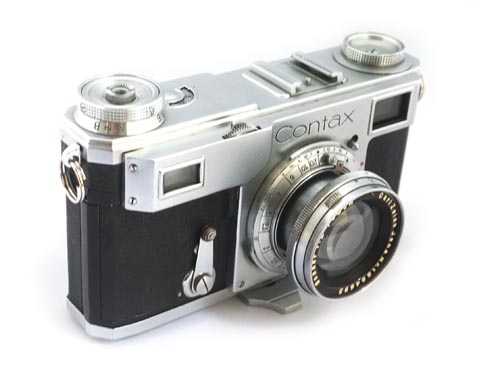
1937 Contax II
Following the not so successful Contax I, Zeiss introduced the Contax II. Competing against Leica, the Contax II was superior in almost every respect, and was quickly embraced by professional photographers everywhere. The most notable feature of the Contax II was the combined rangefinder and viewfinder window, a feature that wouldn't appear on competitors' cameras until after WWII.
Beautifully styled, the Contax II was followed shortly by the Contax III, basically the same camera with a built in light meter. Following WWII, much of the machinery and expertise needed to manufacture the Contax cameras was carted off to Kiev, Ukraine, by the Soviets, where the camera was resurrected as the Kiev (see the Kiev 2 copy below).
This camera is in good working condition, and is equipped with the Carl Zeiss Jena 50/2.0 collapsible lens. Post-war production resumed in Stuttgart, West Germany, with the completely new Contax IIa and Contax IIIa, shown below.
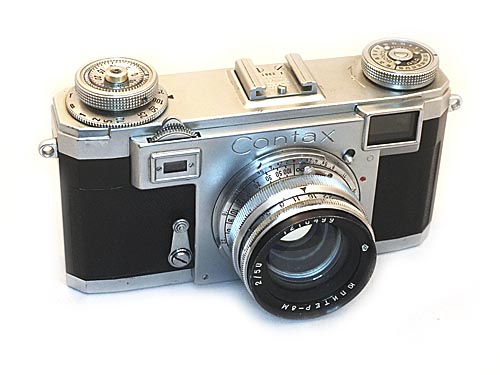
1951 Contax IIa
I can't remember if this is the Contax model my father bought and used after his Argus C3. He may have purchased the Contax IIIa. The post-WWII Contax IIa was smaller and lighter than the Contax II. It also offered some improved features over the Contax II, although some consider the IIa to be less robust than the original II. But they are still fine cameras capable of excellent photographs. The lens is a Jupiter-8 50mm f/2 made for the Soviet Kiev, a Contax clone.
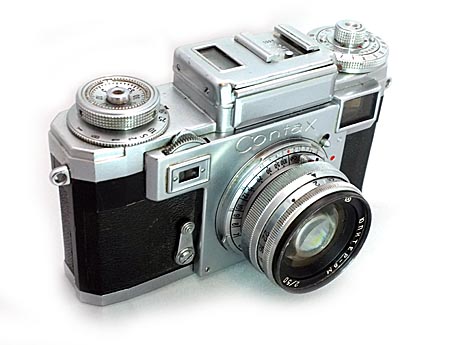
1953 Contax IIIa
The Contax IIIa added a light meter to the basic Contax IIa body. After setting the film speed on the rewind knob scale, the ring on the rewind knob could be turned to match the exposure reading to the correct exposure time for the selected lens aperture. Unfortunately, the selenium cells in the Contax IIIa light meters died decades ago, and replacements are no longer available. But they are still fine cameras capable of excellent photographs. A handheld exposure meter can be used if needed.
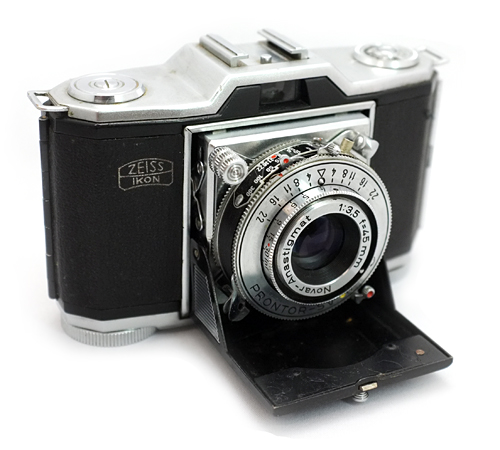
Zeiss Ikon Contina 35 (522/24)
I bought this camera on EBay because it shares some parts with the Contessa below that I needed, but I ended up not being able to use it. The camera cleaned up nicely, but unfortunately, the shutter needs repair. The Zeiss Contina sits between the Zeiss Ikonta 35 and the Contessa 35, and shares some features of both. This is an early model of the Contina and has an optical viewfinder and scale focusing. Later Continas had a rangefinder. The camera features a Novar 45mm f/3.5 lens and a Prontor SV shutter with speeds up to 1/300s and B. Like the many of the cameras of the era, the shutter can't be cocked unless there is film in the camera and the film is advanced, to prevent double exposures.
The last Ikonta models and first Contina models are pretty much identical. The first use of the Contina name appears to be in 1953, although the identical Ikonta was produced in 1951. The folding Contina I and the Contina II with the rangefinder continued to around 1955, after which the camera was produced with a rigid lens.

Zeiss Ikon Contessa 35 (533/24)
A beautifully crafted and superbly engineered camera, the Contessa is a delight to hold. This almost mint model I found on EBay has two flaws: the film counter is not reliable, and a small button that sits in the center of the film advance knob, which when pushed down, enables the film to be rewound, is missing. The plunger it screws on to has broken off.
The Contina shown above uses the same parts. I disassembled the Contina and removed the plunger and button, but when I disassembled the Contessa to install the parts, I found that the film take-up spool is riveted in place, not secured with a screw as in the Contina. The rivet sits under the rangefinder assembly, and while removing the rangefinder isn't a problem, I couldn't see any practical way to drill out the rivet without potentially damaging the camera in some way. And I didn't want to take a chance that replacing the rivet with a screw would work reliably.
I can live without the film counter, or if I remember, I can advance it manually after each exposure. To rewind the film at the end of the roll, I made a little tool I can use to push and hold the plunger down while rewinding the film into the cassette. I won't be using this camera all that often, so it's not a big deal.
The Contessa has a combined view and rangefinder that I found easy to use even with glasses, although some complain the viewfinder eyepiece is rather small, typical of cameras of the era. This later version Contessa has the Synchro-Compur shutter with speeds up to 1/500 second and B. The lens is the very fine Tessar Opton coated 45mm f/2.8. The Contessa also featured a built-in, but uncoupled selenium light meter, which, of course, no longer works.
The Contessa, along with the Kodak Retina II, and the Leica IIIg, are the three cameras I find are fun to shoot 35mm film with.
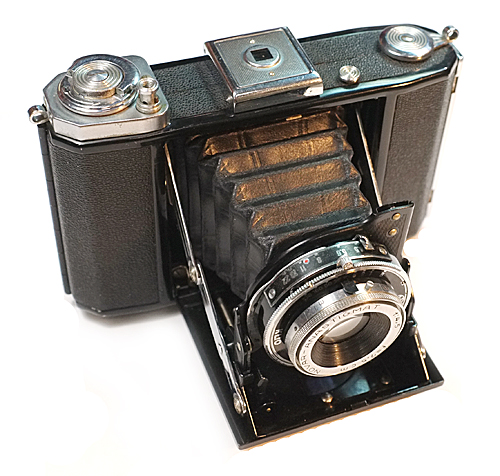
Zeiss Ikon Ikonta B Model 521/16 Medium Format Camera
I ran across this very nice Zeiss Ikonta B on EBay, and bought it based on the nearly mint cosmetic condition. The seller claimed the camera was from an estate sale, and it was sold as "untested." I gambled that the cosmetic condition might indicate a well cared for camera. I was not disappointed when I received the camera. Everything worked, although it could stand a CLA. The lower shutter speeds are a bit slow, and the self-timer was balky. I sprayed a little eletrical contact cleaner into the self-timer mechanism, with improved performance quite a bit. I also removed the rear lens element and cleaned the insides of the front and rear lens elements.
This model is equipped with the Novar f/4.5 lens and a AGC Klio shutter with speeds from 1s to 175s, plus B. This is a pre-WWII lens and shutter combination. The asterisk following the serial number, N 29XXX * indicates that it is most likely a post-WWII model assembled in Stuttgart, Germany, between 1947 and 1949, from pre-war parts manufactured between 1941 and 1943. The Novar lens, a less expensive lens than the Tessar found on the top of the line models, is, nevertheless, a highly regarded lens, especially when stopped down to f/8 or more. The 75mm lens can be set from f/4.5 to f/22.
The camera takes 6x6cm images on 120 roll film. I find the vertically opening lens board much easier to hold and use, and the shutter is on the right, where it is conventionally found on most cameras. The left mounted shutter release on the Super Ikonta shown below and the Voightlander Bessas seems a bit awkward to me. Build quality is excellent in keeping with the Zeiss tradition. The model 521/16 was introduced in 1938, and production ceased in 1951.

Zeiss Ikon Super Ikonta A 531 Medium Format Camera
I found this near mint example on EBay in Canada. The Super Ikonta A Model 531 was introduced in 1934 and discontinued in 1956. The camera takes 16 6cm x 4.5cm images on a roll of 120 film. The coated 75mm/f3.5 lens in this camera was produced in 1953. The camera serial number dates it to 1954.
The shutter is a Synchro-Compur, with a left-hand shutter release, which takes some getting used to. When holding the camera, the right hand is used to focus the rotating wedge range finder (similar to the Zeiss Contessa described above), while the left works the shutter. Although the range finder is coupled to the lens, the image is composed in the pop-up Albada type viewfinder. Shutter speeds range from 1s to 1/500s. A B setting is offered, but no T.
The craftsmanship and build of the camera is exquisite. The controls are just a tad tight due to hardening of the lubricants used back in the 1950's, but otherwise the camera functions perfectly, although I find it somewhat difficult to hold, focus, and shoot with.

Zeiss Ikon Super Ikonta B 532/16 Medium Format Camera
Considered by some to be the best folding cameras ever made, the Zeiss Ikon Super Ikontas were equisitely designed and crafted masterpieces. The B series were 6x6cm format folders, and the model shown here, a post-WWII example from 1953-55, is one of the top versions. It differs primarily from its predecessor, the 530/16, in that it has a combined rangefinder/viewfinder. The camera features a Tessar Opton 80mm f/2.8 lens, apertures from f/2.8 to f/22, and shutter speeds of 1s through 1/500s.
The 532/16 takes eleven 6x6cm images on a roll of 120 film. In a somewhat quirky bit of engineering, Zeiss revised the film advance mechanism to prevent overlapping images, apparently a problem in the 530 model, losing one image in the process. The film advance mechanism also prevented double exposures, and used a film counter to eliminate the need to advance the film using the red film port in the back. In fact, the only time the red port is opened is after first loading film, to set the first exposure. The window is then closed, and film is advanced for subsequent exposures using the film counter on the top plate.
I found this example on EBay, from the seller's personal collection.
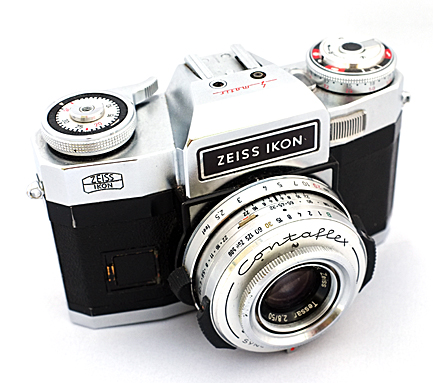
Zeiss Ikon Contaflex Super BC or S "S-Matic"
My daughter found this Contaflex at an estate sale and purchased it for me. Based on my online search, I believe this to be one of the last Contaflex models, either a Super BC or S S-matic, which featured a shutter priority automatic mode.
The Contaflex line was introduced in 1953 and continued until 1968. This model featured a Synchro-Compur X shutter and Tessar f/2.8 50mm lens, in addition to CdS TTL exposure.

Zeiss Box Tengor
The Zeiss Box Tengor has to be one of the most, if not the most, sophisticated box camera ever produced. In production in several versions from 1931 to 1956, the Zeiss Box Tengor was a top shelf camera. The lens, an uncoated two element lens, was an improvement over the single meniscus lenses of most box cameras. The shutter speed was about 1/30 second. The final version, shown here, a 1954 production model, has three f/stops: f/11, f/16, and f/22.
The camera could focus from one meter to infinity, in three ranges: 1 to 2 meters (about 40" to 6.5'), 2 to 8 meters (6.6' to 26'), and 8 meters (26') to infinity. Two bright viewfinders provided portrait and landscape modes, and two tripod sockets permitted mounting the camera in either mode. The shutter release was fitted with lock and a standard threaded cable release. The camera takes eight 6cm x 9cm images on a roll of 120 film.
I found this example on EBay from a German seller. The camera is in like new condition and in good working order. No servicing was required. See a sample photo the Gallery of Images from Vintage Cameras.
Other German Cameras

Futura-S 35mm Rangefinder Camera
The Futura-S was a well-made rangefinder 35mm camera made in Germany from about 1950 to 1955. This one belonged to my son-in-law's father.
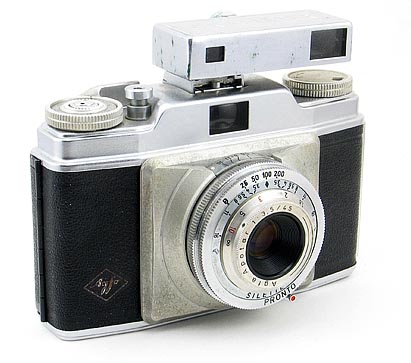
Agfa Silette 35mm Camera
This was my first 35mm camera. I got it for my fourteenth birthday in 1957. It is a solid, but very basic 35mm camera with optical viewfinder featuring an Agfa Apotar 45mm f/3.5 lens and shutter speeds to 1/200. I added the accessory rangefinder.

Rolleiflex 4x4 Baby Grey
This grey "Baby" Rolleiflex belonged to my mother. The Baby Rolleiflex was introduced in 1957 and used 127 film. The mounted 4x4cm slides were the same frame size as 35mm slides, and became very popular as "super slides." This camera was my mother's second Baby Rolleiflex. Her first one was lost in a rafting accident on the Tanana River in Alaska, which almost cost my parents their lives as well.

1935 & 1937 Voigtlander Bessa 6X9 Folding 120 Roll Film Cameras
The Voigtlander Bessa folding 120 roll film cameras were manufactured from 1929 to 1949, and there are several variations as improvements were made during the two decades of production. Shown here are a circa 1935 Bessa and a post-1937 Bessa. Both cameras feature the very fine Skopar lenses. The cameras shoot 6x9cm images on 120 roll film. The cameras originally came with masks to allow shooting 6 x 4.5cm images as well, but the masks are usually missing. Both these cameras are in very good cosmetic, mechanical, and optical condition.
The camera below left was produced between 1935 and 1937. It has the door-mounted shutter release, but the pop-up Albada viewfinder lacks the protective cover of the later models, and it retains the brilliant finder, a carry-over from the original model of 1929. The f/4.5 Skopar lens is coupled with a Compur shutter, with speeds from 1s to 1/250s, plus T and B. The lens stops down to f/22.
The version below right is a 1937-1939 model with covered pop-up viewfinder. The brilliant, or reflex, finder was dropped sometime during the production run, as versions of the 1937 model can be found with or without it. The lens is a faster f/3.5 Skopar and stops down to f/22. The shutter is a Prontor II sychronized for flash, with shutter speeds from 1s to 1/200s. I added an accessory shoe, and I found a very nice Voigtlander shoe-mount rangefinder to use with the camera (above, left)
Voigtlander also intruoduced a rangefinder version, known as the Bessa RF, in the late 1930's. In 1940, the Bessa I was introduced. It featured a bright top plate with a built-in viewfinder, but no rangefinder. Production of the Bessa folding cameras resumed after WWII until 1949. Post-war lenses are reportedly coated. The pre-war Bessa RF evolved into the Bessa II, which featured a coupled rangefinder. The Bessa II was produced from 1950 to 1956.
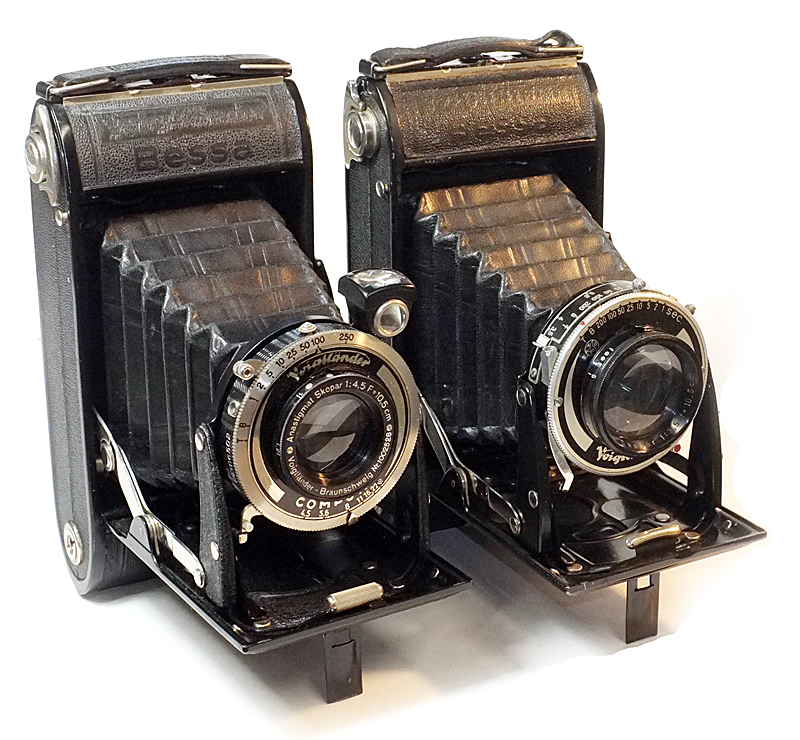
In 2008, Fujifilm and Cosina created a Japanese designed Bessa III folding camera, also sold as the Fuji GF670. Other than the name, the Bessa III has no relation to Voigtlander or Bessa cameras made in Germany up through the 1950's. The Japanese designed and built Bessa III was discontinued in 2014, and remains a sought after camera.
Vintage German Cameras
Vintage Domestic Cameras
Vintage Japanese Cameras
Vintage Former Soviet Union Cameras
Vintage Polaroid Cameras
Vintage Prime Lens Comparison
Vintage Photography Accessories
Gallery of Images from Vintage Cameras
Home




















